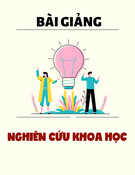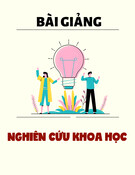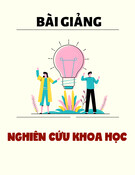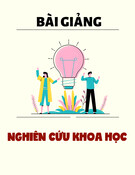
ISSN 1859-1531 - TẠP CHÍ KHOA HỌC VÀ CÔNG NGHỆ - ĐẠI HỌC ĐÀ NẴNG, VOL. 22, NO. 11A, 2024 83
PERCEPTION AND PRACTICES OF EFL TEACHERS TOWARDS TEACHING
SOCIO- CULTURAL CONTENTS FOR 10th GRADERS AT
LE HUU TRAC HIGH SCHOOL, DAK LAK PROVINCE
NHẬN THỨC VÀ THỰC TẾ GIẢNG DẠY CỦA GIÁO VIÊN TIẾNG ANH ĐỐI VỚI
VIỆC DẠY NỘI DUNG VĂN HOÁ - XÃ HỘI CHO HỌC SINH LỚP 10 TẠI
TRƯỜNG THPT LÊ HỮU TRÁC, TỈNH ĐĂK LĂK
Luong Hien Bao Thanh1, Nguyen Thi Quynh Hoa2*
1Master Student of the Course in Theory and Methodology of English Teaching 43 (2021-2024), UD-UFLS, Vietnam
2The University of Danang - University of Foreign Language Studies, Vietnam
*Corresponding author: ntqhoa@ufl.udn.vn
(Received: October 07, 2024; Revised: November 23, 2024; Accepted: November 25, 2024)
Abstract - The 2018 General Education Program (GEP) has
significantly reformed the Vietnamese education system. One of its
requirements is for students to respect cultural diversity. This article
aims at examining English as a Foreign Language (EFL) teachers’
perception and practices toward teaching socio-cultural contents
(SCC) presented in the new textbook, “Tieng Anh 10 - Global
Success”, for 10th graders. It employs qualitative methods with the
support of quantitative information. The study applies a
questionnaire, semi-structured interviews, classroom observations
and teaching materials to collect data from seven teachers at Le Huu
Trac (LHT) High School. The findings reveal that most teachers
appreciate socio-cultural integrations (SCI) and agree that SCI does
not prevent progress in terms of language accuracy. SCI’s
motivational benefits and positive impacts on learners' language skills
were approved. However, teachers devote little time and effort to
SCI. The study also proposes several implications and suggestions.
Tóm tắt - Chương trình giáo dục tổng thể 2018 đã cải cách đáng
kể hệ thống giáo dục Việt Nam. Một trong những yêu cầu của
chương trình là học sinh biết tôn trọng sự đa dạng văn hóa. Bài
viết này nhằm khảo sát nhận thức và thực hành của giáo viên
(GV) tiếng Anh đối với nội dung văn hóa xã hội (VHXH) trong
cuốn sách giáo khoa mới, “Tiếng Anh 10 - Global Success”.
Nghiên cứu áp dụng phương pháp định tính với sự hỗ trợ của
thông tin định lượng. Bảng hỏi, phỏng vấn, dự giờ và tài liệu
giảng dạy được sử dụng để thu thập dữ liệu từ bảy GV trường
trung học phổ thông LHT. Kết quả cho thấy hầu hết GV đánh
giá cao việc tích hợp VHXH và đồng ý rằng nó không cản trở
tiến bộ về mặt ngôn ngữ. Những lợi ích và tác động tích cực của
việc tích hợp VHXH đối với kỹ năng ngôn ngữ của người học
cũng được công nhận. Tuy nhiên, GV dành ít thời gian và nỗ
lực cho việc tích hợp VHXH. Nghiên cứu cũng đề xuất một số
khuyến nghị và gợi ý.
Key words - Socio-cultural teaching; English language teaching;
integration of socio-cultural contents; teacher perception;
classroom practices
Từ khóa - Giảng dạy văn hóa xã hội; giảng dạy Tiếng Anh; tích
hợp nội dung văn hóa xã hội; nhận thức của giáo viên; thực hành
trong lớp học
1. Rationale
Language learning is not only about grammatical
structures and vocabulary but also about socio-cultural
(SC) understanding as Byram [1, p.52] indicates “language
and culture cannot be treated separately in the discussion
of language teaching theory and practice”. By SCI in
language teaching, teachers can help students become
more proficient communicators and promote their
appreciation for diverse cultures.
The 2018 GEP of the Ministry of Education and
Training has brought about significant reforms to the
Vietnamese education system. It outlines that foreign
language (FL) subjects should help students use the
language effectively for learning and communication to
meet the demands of human resource development in the
country's industrialization, modernization, and
international integration efforts. Obviously, ELT now
should also focus on SCI. However, in Viet Nam, SCI in
ELT has been neglected. Hoa and Vien [2, p.454] propose
“From the problems of intercultural teaching perception
and practices, it is assumed that intercultural integration
was not implemented properly”, and Long [3, p.134] states
“Teachers focused more on the development of language
knowledge and skills, thus giving cultural knowledge a
marginal status”
In the academic year 2023-2024, LHT High School first
implemented "Tieng Anh 10 - Global Success” textbook,
emerging for its prominent features, particularly its SCC.
Understanding how teachers perceive and implement the
SCC within the textbook is crucial for evaluating its
effectiveness in promoting cultural awareness and
communicative competence among students. These
inquiries motivate me to conduct a study on EFL teachers'
perception and practices regarding the teaching of SCC for
10th graders at LHT High School, Dak Lak province.
2. Literature Review
2.1. Theoretical Background
2.1.1. The Concept of Socio-Cultural Contents
Sociologists described society as a collection of people
who inhabit a shared territory, engage with one another,
and possess a common culture. In his book, Aricinas [4]
defines society as a group of individuals who share a
specific territory and culture.
Tang [5] noted despite numerous attempts to define the

84 Luong Hien Bao Thanh, Nguyen Thi Quynh Hoa
term “Culture,” scholars have not yet reached a universal
concept. However, President Ho Chi Minh’s definition, as
quoted by Nguyet [6] in her article encapsulated the
broadest understanding of the cultural domain “For the
sake of survival and the purpose of life, humanity has
created and invented language, writing, ethics, law,
science, religion, literature, art, and tools for daily living,
including clothing, food, and shelter, as well as various
methods of their use. All of these creations and inventions
constitute culture.”
A textbook’s SCC, as can be drawn from these
concepts, refers to the incorporation of topics, themes, and
materials that delve into the social and cultural aspects of a
specific language or community. They may cover cultural
practices, traditions, customs, values, social issues,
historical events, literature, and art forms.
2.1.2. The Relationship of Society, Culture and Language
Ntara [7] proposed society and culture are inseparable,
as culture shapes social structures and behaviors, while
society provides the context for cultural expression and
transmission. Society cannot be separated from its culture,
as culture is essential to its identity.
Mitchell and Myles [8, p.235] argued that “Language
and culture are not separated, but are acquired together,
with each providing support for the development of the
other”. According to Liddicoat et al. [9], language and
culture are intricately intertwined, with culture influencing
and being integrated into all aspects of language, leaving
no level of language independent of cultural influence
(Figure 1).
Figure 1. Points of articulation between culture and
language
2.1.3. Integrating Socio-Cultural Contents into Language
Learning and Teaching
Effective communication extends beyond grammar and
vocabulary; it encompasses cultural understanding as well.
A language learner who solely acquires grammar and
vocabulary lacks the necessary tools to effectively
communicate in that language.
Onalan [10], in his study, indicated learning the cultural
aspects in the process of language learning enhances
students' cultural awareness, empathy, and intercultural
competence. Mazari and Derraz, [11] added that it
broadens their perspectives, fosters respect for diversity,
and promotes a deeper understanding of different societies
and their values.
2.1.4. Overview of the Global Success Textbook Series
Foreign language teaching and learning have always
been concerned by the Vietnamese Government. In 2008,
the Ministry of Education and Training launched the
National Foreign Language 2020 project, which
particularly emphasizes enhancing the English
curriculum. In comparison to the previous one, English is
introduced three years earlier. Students are going to have
English as a compulsory subject from grade 3 instead of
grade 6. Many new textbook series are delivered in this
context including the Global Success series, which is
regarded as having exceptional qualities that enhance
English language teaching and learning. In the view of
Phong [12], the book series provides a thorough learning
path that satisfies the requirements for widespread
English language teaching and learning throughout the
nation.
2.1.5. Introduction of "Tieng Anh 10 – Global Success"
"Tieng Anh 10 – Global Success" was officially
approved by the Minister of Education and Training on
January 28th, 2022. It is included in the list of English
textbooks for grade 10 to be used in general education
institutions from the academic year 2022-2023 under
Decision No. 442/QĐ-BGDĐT. By accomplishing “Tieng
Anh 10 – Global Success”, students can achieve level B1
proficiency according to the Common European
Framework of Reference for Languages (CEFR).
The textbook revolves around four themes "Our Lives,"
"Our Society," "Our Environment," and "Our Future",
which are explored in ten units. It is well designed for a
diverse class with students of different proficiency levels,
according to Que and Anh [13, p.428], “There are different
topics and tasks offered for various learner levels, learning
preferences, and interests”. They added that the textbook
also covers all language skills, grammar, vocabulary, and
pronunciation.
2.2. Previous Related Studies
In the field of second language acquisition, SCI in
teaching and learning have been widely explored by
numerous researchers in the world (Onalan; Gonen and
Saglam), and in Viet Nam (Long; Hoa and Vien).
Onalan investigated teachers’ perceptions of culture,
describing FL study as a means to gain exposure to diverse
cultures, contributing to a "global understanding of other
cultures and people". He emphasized the importance of
cultural knowledge for effective communication, noting
that teachers primarily include cultural content to motivate
students and enhance cultural awareness rather than change
behaviors. Teaching culture should also align with
learners’ ages and proficiency levels to create effective
EFL classrooms.
Gonen and Saglam explored teachers' perspectives on
the role of culture in FL education. They found that while
opinions varied on which cultural aspects to prioritize,
teachers generally agreed that culture is essential.
Familiarizing students with the target culture enhances
their understanding of its traditions and values while
helping them appreciate their own cultural diversity.

ISSN 1859-1531 - TẠP CHÍ KHOA HỌC VÀ CÔNG NGHỆ - ĐẠI HỌC ĐÀ NẴNG, VOL. 22, NO. 11A, 2024 85
However, teachers' approaches are significantly influenced
by curriculum requirements and limitations.
In 2013, Long's dissertation examined how Vietnamese
university EFL teachers integrate culture into their
teaching. The qualitative study revealed that while teachers
understood culture well, their goals for incorporating it
were limited, and they lacked adequate support from
professional development programs to enhance their
intercultural competence.
In their study, Hoa and Vien investigated teachers’
beliefs regarding intercultural integration. The findings
revealed a solid understanding of intercultural integration
but highlighted concerns about curriculum and
management, suggesting a need for improving
intercultural instruction and aligned educational
management.
3. Research Methodology
The study aims at investigating the perception and
practices of EFL teachers toward teaching SCC to 10th
graders. Therefore, the researcher employs the qualitative
method with the support of quantitative data.
The study was conducted in Dak Lak province with a
total sampling of seven EFL teachers who are teaching
10th graders at LHT High School, Dak Lak province.
These teachers are coded as A1, A2, A3, A4, A5, A6
and A7.
Table 1 below illustrates the teachers’ background
information.
Table 1. Participants’ Demographic Information
No.
Percentage
Gender
Male
1
14,3
Female
6
85,7
Years of
teaching
10 to 15
3
42,8
15 to 20
3
42,8
More than 20
1
14,3
Educational
degrees
M.A.
1
14,3
B.A.
6
85,7
Based on the theoretical results and research objectives,
the researcher created a questionnaire. After collecting, all
the responses were analyzed and reported in a reader-
friendly way. Then the researcher created semi-structured
interview’s questions, conducted classroom observations,
and collected teaching materials.
The 20 items of the questionnaires were separated into
three parts. All items are adopted from previous studies of
Gonen and Saglam [14], Que and Anh, Dema and Moeller
[15] and adapted with some adjustments to fit the aim of
the current study.
The qualitative data was collected from semi-structured
interviews, classroom observations, and teaching
materials. According to Seidman [16], interviews
facilitated knowledge construction via social interaction,
aiming at providing a balanced understanding of the
research topic rather than verify hypotheses. Direct
classroom observations and the collection of teaching
materials could offer insights into how participants address
SCC in their English language teaching.
All data, then, was processed together by using a
thematic analysis approach to answer the research’s
questions. Gibson and Brown, [17] presented an
assumption on thematic analysis that it is a method used to
examine collected data and identify similarities,
differences, and relationships within it. Braun and Clark
[18], suggested that the purpose of thematic analysis is to
uncover patterned beliefs and behaviors shared among the
participants, providing valuable insights into the research
questions.
4. Findings and Discussion
4.1. EFL Teachers’ Perception towards the Teaching of
SCC in English language teaching
To identify EFL teachers’ perception towards the
teaching of SCC in English language teaching and
learning, the researcher collects data from the
questionnaire and the semi-structured interviews.
Table 2 gives more detailed information on EFL
teachers’ perspectives of SCI.
Table 2. SCI - EFL Teachers’ Perception
Items of the Questionnaire
No.
Percentage
1. In a FL classroom,
teaching SCC is as important
as teaching the FL.
Agree
6
85.7
Undecided
1
14.3
Disagree
0
0
2. The study of SCC in
FL classes can hinder
progress in linguistic
accuracy.
Agree
1
14.3
Undecided
1
14.3
Disagree
5
71.4
3. The development of
SC awareness should be
kept only for the most
advanced levels.
Agree
0
0
Undecided
0
0
Disagree
7
100
4. Teaching SCC
motivates students.
Agree
5
71.4
Undecided
0
0
Disagree
2
28.6
5. Combining language
and SCC helps learners
improve their language
skills.
Agree
5
71.4
Undecided
1
14.3
Disagree
1
14.3
The table above presents the teachers' varied
perspectives on incorporating SCC in FL classrooms.
Notably, 85.7% of the teachers believe that teaching SCC
is as important as teaching the FL itself. This indicates
widespread recognition of the significance of SCI.
Regarding item 2, the majority (71.4%) disagree that SCI
hinders progress in linguistic accuracy, suggesting teachers
generally do not view SCI as a barrier to language skill
development. All teachers oppose the idea of limiting SCI
to advanced learners, which emphasizes its importance
across proficiency levels. 71.4% of the teachers also agree
that teaching SCC motivates students, highlighting the
positive impact of this approach in ELT. Similarly, 71.4%
of teachers believe combining language and SCC helps
improve learners' language abilities. This reinforces the
benefits of SCI.

86 Luong Hien Bao Thanh, Nguyen Thi Quynh Hoa
Referring to the interviews, most teachers recognize the
significance of SCI in ELT. Teacher A6 notes, “Not
understanding others' societies and cultures can be a barrier
to communication”. Similarly, Teacher A3 states,
“Including SCC in ELT promotes understanding and
improves communication skills. Teaching SCC is as
important as teaching skills or vocabulary.” Furthermore,
teachers emphasized the motivational benefits and positive
impacts of SCI on learners' language skill development.
Teacher A1 highlights, “Students are often more motivated
to learn when they can relate the material to their own lives
and experiences or when they are curious about other
cultures”.
4.2. EFL Teachers’ Perception towards the SCC
Presented in “Tieng Anh 10 – Global Success” Textbook.
The data collected from the interviews and part two of
the questionnaire are used for analyzing EFL teachers’
opinions toward the SCC presented in the textbook “Tieng
Anh 10 – Global Success”.
Table 3 summarizes teachers’ perception collected
from the questionnaire.
Table 3. SCC Presented in the Textbook “Tieng Anh 10 –
Global Success”- EFL Teachers’ Perception
Items of Questionnaire
No.
Percentage
6. The textbook provides
accurate and reliable
SCC.
Agree
5
71.4
Undecided
0
0
Disagree
2
28.6
7. The textbook covers a
wide range of SCC.
Agree
6
85.7
Undecided
1
14.3
Disagree
0
0
8. The textbook provides
opportunities for students
to explore SCC in depth.
Agree
1
14.3
Undecided
5
71.4
Disagree
1
14.3
9. The textbook provides
support for teachers in
delivering SCC
effectively.
Agree
5
71.4
Undecided
0
0
Disagree
2
28.6
10. The textbook offers
enough materials for
learning and discussing
SCC.
Agree
4
57.1
Undecided
1
14.3
Disagree
2
28.6
As we can see from the table, the majority of the
teachers perceive the textbook’ SCC to be accurate,
reliable, and diverse. Specifically, 71.4% agree that the
textbook provides accurate and reliable SCC, and 85.7%
agree on the textbook's wide range of these contents,
which indicates a positive perception of its
comprehensiveness.
Regarding Item 8, only 14.3% agree that the textbook
provides opportunities for in-depth exploration of SCC,
while a significant 71.4% are undecided. This indicates a
critical area for improvement, as many teachers may
perceive the textbook as lacking depth in this aspect,
leading to uncertainty about its effectiveness in fostering
deeper understanding.
Although 71.4% believe that the textbook supports
teachers in delivering SCC effectively, just over half
(57.1%) of the teachers agree that the textbook offers
enough materials for learning and discussing SCC,
indicating that there may be gaps in the materials provided.
In the interviews, Teacher A6 states, “The textbook is
a good source of SCC because it covers many different
areas, such as the inclusion of diverse topics, authentic
materials, and the promotion of critical thinking.” Teacher
A3 adds, “The book is designed with vivid images to
illustrate the learning content.”
However, Teacher A2 raises the concern that while the
textbook covers a broad variety of topics, it lacks sufficient
materials for exploring and discussing SCC in depth. She
emphasizes the necessity for teachers to seek additional
resources to enhance the effectiveness and
comprehensibility of their lessons, stating, “I think it
covers a wide range, but it doesn’t provide enough
materials for learning and discussing SCC. Teachers really
need to find more resources if they want their lessons to be
effective and understandable”.
4.3. EFL Teachers’ Practices Regarding the Teaching of
SCC
The researcher used a variety of data instruments to
determine EFL teachers’ practices of SCC presented in the
textbook “Tieng Anh 10 - Global Success”. These
instruments included part three of the questionnaire,
classroom observations and a collection of teaching
materials.
Findings from Questionnaire
Table 4 shows approaches that teachers may use to
address SCI.
Table 4. SCI - Teachers’ Practices
Items of Questionnaire
Code
11. I use pictures that I prepare beforehand to present a
typical image of SCC.
SC11
12. I have my students bring cultural artifacts or real
objects and present them to the rest of the class.
SC12
13. I use authentic materials like videos, articles, songs,
or advertisements, TV shows, movies…. to illustrate the
SCC.
SC13
14. I ask students to prepare presentations on specific
SCC featured in the textbook.
SC14
15. I facilitate class discussions on SC topics raised in
the textbook.
SC15
16. I encourage students to share their perspectives,
experiences, and insights related to the SCC presented.
SC16
17. I assign tasks that involve comparing and
contrasting SC practices, customs, or traditions between
different countries or regions.
SC17
18. I encourage students to explore the causes of
differences between home and foreign SCC.
SC18
19. I get my students to evaluate their home and foreign
SCC from different views.
SC19
20. I design role-play activities that simulate real-life
SC encounters or situations.
SC20
The frequency of the items above is shown in the
following figure.

ISSN 1859-1531 - TẠP CHÍ KHOA HỌC VÀ CÔNG NGHỆ - ĐẠI HỌC ĐÀ NẴNG, VOL. 22, NO. 11A, 2024 87
Figure 2 describes the preferences of teachers for
practicing SCC and reveals distinct patterns in their
choices. Item 14 stands out as the most popular approach,
closely followed by items 13 and 11. This indicates a
strong commitment to actively involving students in their
learning process and to visually representing SC elements
with relevant and engaging resources, which helps students
better understand the SCC. By focusing on these strategies,
teachers can enhance students' learning experiences and
deepen their understanding of the SCC.
Figure 2. The Frequency of EFL Teachers’ SCI
Regarding items 15, 16 and 18, the 42.9% of frequency
suggests that teachers value discussions and students
sharing their perspectives, experiences, and insights related
to the SCC. These approaches can help deepen
understanding and encourage critical thinking about SC
issues.
The low-frequency percentages of items 17 and 20,
with only 14.3%, show a missed opportunity for students
to engage in critical analysis and gain a broader
understanding of SC differences. This also suggests that
experiential learning methods, which can be effective for
teaching SCC, are not being used much.
Notably, items 12 and 19 did not receive any approvals
as preferred methods for practicing SCC. This indicates a
lack of engagement in hands-on cultural exploration,
which is important for helping students connect with
different cultures. It also shows that there is not enough
emphasis on reflective thinking about students’ own
cultural backgrounds. Without these practices, students
may miss the chance to deepen their understanding of both
their culture and others, which is essential for effective
learning SCC in FL classes.
Findings from Classroom Observations
To collect data from classroom observations, the
researcher observes 21 lessons, among these, only six
lessons are included with SCC. Table 5 gives a more
detailed description of SCC integrated lessons.
By observing lessons, the researcher identified that the
teachers allocated limited time and focused on addressing
SCC in their ELT. As can be seen from Table 5, only six
out of 21 observed lessons are integrated with SCC
presented in the textbook. Moreover, educators dedicated
approximately 3 to 12 minutes of a 45-minute class to SCI,
representing about 25% of the total lesson time.
As previously mentioned, seven teachers are
participating in the research coding A1, A2, A3, A4, A5,
A6 and A7. Thus, it can be observed from the table that
only four (A1, A2, A3, A6) out of the seven teachers
included SCC in their English lessons.
Table 5. Classroom’s Observations
Teacher
Lessons
SCI’s
Stage
& Time
Aims
A1
Unit 6.
Gender Equality
Lesson 1.
Warm-up
(3’)
To discuss SC topics
raised in the textbook
A1
Unit 6.
Gender Equality
Lesson 3.
Warm-up
Pre-stage
(9’)
To discuss SC topics
raised in the textbook
A2
Warm-up
Pre-stage (9’)
To discuss SC topics
raised in the textbook
A3
Pre-stage
Post-stage
(12’)
To present a specific
SC topic featured in
the textbook
A6
Unit 6.
Gender Equality
Lesson 7.
CLIL (5’)
To present a specific
SC topic featured in
the textbook
A6
Unit 8.
New Ways to Learn
Lesson 7.
Culture &
CLIL (8’)
To discuss SC topics
raised in the textbook
Upon careful analysis of the classroom observation
data, it becomes evident that the integration of SC
knowledge into language instruction is not given
significant emphasis. Furthermore, only about 28% of
observed lessons included integrated SCC. This trend
emphasizes a prevalent tendency where the time and focus
allocated to SC knowledge remain relatively limited.
Finding from Teaching Materials
Teaching materials collected from the teachers mainly
include lesson plans and powerpoint presentations.
Notably, all the lesson plans are taken from teaching
resources provided by the publisher without any
adaptation. The powerpoint presentations are adapted to fit
the students’ ability and teaching situations. Most teachers
skip over SCC.
Moreover, an additional discernment was made
regarding the simultaneous use of the e-book iteration of
the textbook accessible on the Sachmem.vn platform.
This practice underscores a prevailing reliance on
externally provided educational materials, suggesting a
limited degree of customization or personalization in the
instructional content delivery processes conducted by
educators within the academic setting.
In short, this section aimed to explore how EFL
teachers practice teaching SCC. The questionnaire’s data
analysis revealed that the teachers at LHT High School
utilized various teaching methods to cover SC topics in
their lessons, though not frequently. However,
0%
10%
20%
30%
40%
50%
60%
70%
80%
90%
100%
Always
Often
Sometimes
Rarely
Never



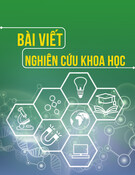


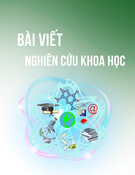


![Câu hỏi ôn tập môn Tâm lý học giáo dục [chuẩn nhất]](https://cdn.tailieu.vn/images/document/thumbnail/2025/20250710/kimphuong1001/135x160/59611752136982.jpg)
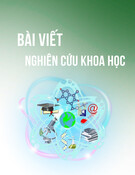


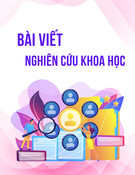
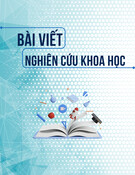
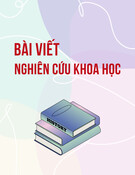
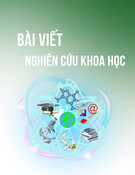
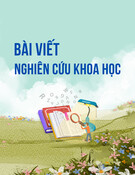
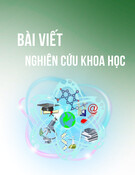
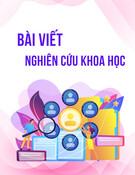
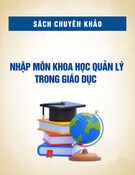
![Định hướng giáo dục STEM trong trường trung học: Tài liệu [chuẩn/mới nhất]](https://cdn.tailieu.vn/images/document/thumbnail/2025/20251124/dbui65015@gmail.com/135x160/25561764038505.jpg)
